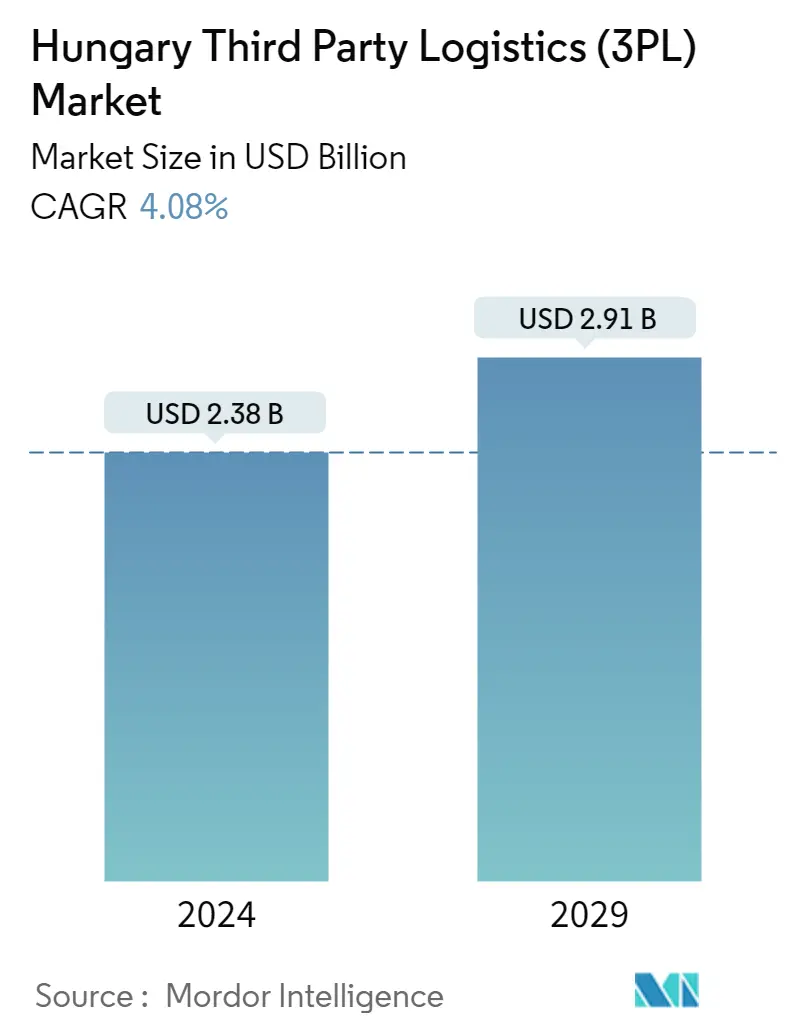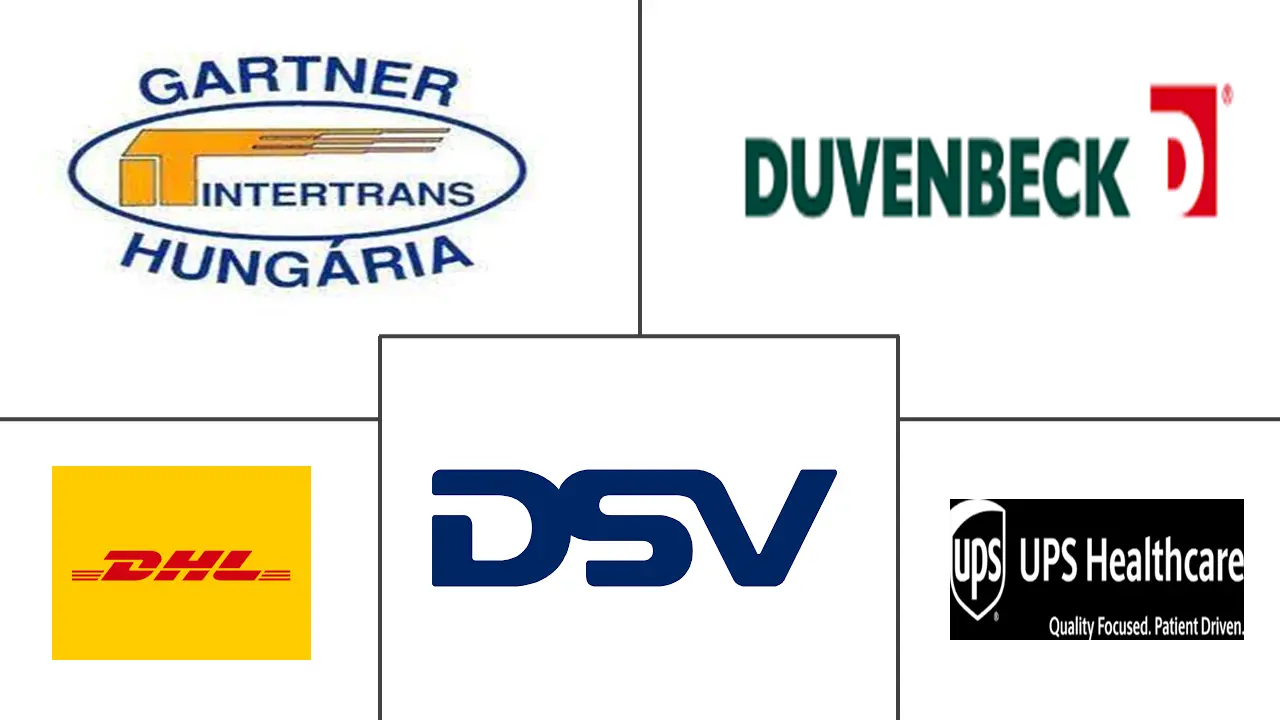Market Size of Hungary Third Party Logistics (3PL) Industry

| Study Period | 2019 - 2029 |
| Base Year For Estimation | 2023 |
| Market Size (2024) | USD 2.38 Billion |
| Market Size (2029) | USD 2.91 Billion |
| CAGR (2024 - 2029) | 4.08 % |
| Market Concentration | Low |
Major Players
*Disclaimer: Major Players sorted in no particular order |
Hungary 3PL Market Analysis
The Hungary Third Party Logistics Market size is estimated at USD 2.38 billion in 2024, and is expected to reach USD 2.91 billion by 2029, growing at a CAGR of 4.08% during the forecast period (2024-2029).
- The COVID-19 epidemic directly impacted companies involved in the flow, storage, and transfer of commodities. Logistics companies enabled trade and commerce and assisted companies in getting their products to clients as an essential component of value chains both domestically and beyond international borders. Hence, supply chain interruptions caused by the pandemic affected the sector's competitiveness, economic expansion, and job creation.
- The Hungarian logistics market comprises one of the largest third-party providers offering sophisticated services, consistent flexibility, complete reliability, highly competitive prices, and stable and constant growth.
- The future of goods traffic in the Hungarian market is auspicious in terms of transportation logistics. Throughout the past fifteen years, Hungary's road network has seen significant growth, and more recently, work has begun on developing and modernizing the country's railway lines. While rail transportation is either stagnant or hardly increasing, the amount of commodities delivered by road is rising steadily.
- The ability to convert to cleaner, more energy-efficient means of transportation will be improved. New technologies were helped to proliferate by digitalization. Fast, automated handling and classification of commodities became possible because of containerization. Systems for tracking products at the levels of goods, cargo, and modes of transportation are needed for these new solutions.
- Hungary will take advantage of its advantageous geographic location and function as a link between the west and east of Europe to become the logistical service center of the region thanks to the advancements and investments of recent years. Decentralization of the country's geography and advances in technology and infrastructure enable it to fulfill future logistical demands.
- The growth in the market is expected to be driven by the increasing demand for services at industrial parks and logistics center supply chain management. With a unique central position in Europe, the country is possed by four Pan-European Transport Corridors (TEN-T), the relatively low price level in the logistics market, and substantial modern warehouse capacity in the surrounding hospital is becoming a regional distribution center of industries like automobile and pharmaceutical.
Hungary 3PL Industry Segmentation
Third-party logistics companies provide services that have to do with the logistics of the supply chain. This includes transportation, warehousing, picking and packing, inventory forecasting, order fulfillment, packaging, and freight forwarding.
A 3PL (third-party logistics) provider offers outsourced logistics services, which encompass the management of one or more facets of procurement and fulfillment activities. In business, 3PL has a broad meaning that applies to any service contract that involves storing or shipping items. A 3PL service may be a single provider, such as transportation or warehouse storage, or a systemwide bundle of services capable of handling supply chain management.
A comprehensive background analysis of the Hungary 3PL Market covers current market trends, restraints, technological updates, and detailed information on various segments and the industry's competitive landscape. The impact of COVID-19 has also been incorporated and considered during the study.
The Hungary Third- Party Logistics (3PL) market is segmented by type (Domestic Transportation Management, International Transportation Management, and Value-added Warehousing and Distribution) and by end-users (Manufacturing & Automotive, Oil & Gas and Chemicals, Distributive Trade (Wholesale and Retail trade including e-commerce), Pharma & Healthcare, Construction, and other end-users). The report offers the market size and forecast in value (USD billion) for all the above segments.
| By Services | |
| Domestic Transportation Management | |
| International Transportation Management | |
| Value-added Warehousing and Distribution |
| By End-User | |
| Automobile & Manufacturing | |
| Oil & Gas and Chemicals | |
| Construction | |
| Distributive Trade (Wholesale and Retail trade including e-commerce) | |
| Pharma & Healthcare |
Hungary Third Party Logistics (3PL) Market Size Summary
The Hungary Third Party Logistics (3PL) market is poised for steady growth, driven by its strategic geographic location and advancements in infrastructure and technology. The market is characterized by a robust network of local and international players offering a range of sophisticated logistics services. The country's road network has seen significant development, facilitating an increase in road transportation of goods, while rail transportation remains relatively stagnant. The logistics sector is adapting to new technologies and digitalization, which have enabled faster and more efficient handling and tracking of goods. Hungary's position as a link between Western and Eastern Europe, coupled with its competitive pricing and modern warehouse capacities, positions it as a regional logistics hub, particularly for industries such as automotive and pharmaceuticals.
The warehousing sector in Hungary is experiencing a surge in demand, driven by the need for innovative solutions in inventory management and storage to support industrial production. The chemical industry, a major contributor to the country's economy, along with the rubber, tire, and plastics industries, are expanding their production and storage capabilities to meet rising demand. This growth necessitates specialized logistics services, including temperature-controlled and containerized transportation. Recent investments by companies like TEVA Pharmaceutical Industries and PEPCO in automated and technologically advanced distribution centers highlight the ongoing expansion and modernization of logistics facilities in the region. The Hungarian 3PL market is expected to continue its upward trajectory, supported by these developments and the increasing demand for efficient supply chain management solutions.
Hungary Third Party Logistics (3PL) Market Size - Table of Contents
-
1. MARKET DYNAMICS AND INSIGHTS
-
1.1 Current Market Scenario
-
1.2 Market Dynamics
-
1.2.1 Drivers
-
1.2.2 Restraints
-
1.2.3 Opportunities
-
-
1.3 Value Chain / Supply Chain Analysis
-
1.4 Industry Policies and Regulations
-
1.5 General Trends in Warehousing Market
-
1.6 Demand From Other Segments, such as CEP, Last Mile Delivery, Cold Chain Logistics Etc.
-
1.7 Insights on E-commerce Business
-
1.8 Technological Developments in the Logistics Sector
-
1.9 Industry Attractiveness - Porter's Five Forces Analysis
-
1.9.1 Threat of New Entrants
-
1.9.2 Bargaining Power of Buyers/Consumers
-
1.9.3 Bargaining Power of Suppliers
-
1.9.4 Threat of Substitute Products
-
1.9.5 Intensity of Competitive Rivalry
-
-
-
2. MARKET SEGMENTATION
-
2.1 By Services
-
2.1.1 Domestic Transportation Management
-
2.1.2 International Transportation Management
-
2.1.3 Value-added Warehousing and Distribution
-
-
2.2 By End-User
-
2.2.1 Automobile & Manufacturing
-
2.2.2 Oil & Gas and Chemicals
-
2.2.3 Construction
-
2.2.4 Distributive Trade (Wholesale and Retail trade including e-commerce)
-
2.2.5 Pharma & Healthcare
-
-
Hungary Third Party Logistics (3PL) Market Size FAQs
How big is the Hungary Third Party Logistics (3PL) Market?
The Hungary Third Party Logistics (3PL) Market size is expected to reach USD 2.38 billion in 2024 and grow at a CAGR of 4.08% to reach USD 2.91 billion by 2029.
What is the current Hungary Third Party Logistics (3PL) Market size?
In 2024, the Hungary Third Party Logistics (3PL) Market size is expected to reach USD 2.38 billion.

